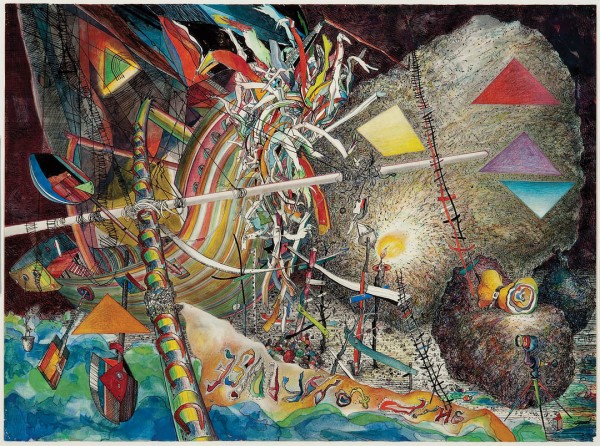‘Robert S. Neuman’s “Ship to Paradise”‘

“Ship to Paradise — The Wreck” is a 1985 image in mixed media on paper from Robert Neuman’s “Ship to Paradise” series.
Coming to Bates from the Heckscher Museum in Huntington, N.Y., Robert S. Neuman’s “Ship to Paradise” is the artist’s personal exploration of a theme that dates back to the Middle Ages: the folly and foibles of man. The exhibition comprises lithographs and etchings, along with preliminary drawings and several etching plates.
Informed by his reflections on the world around him and by a knowledge of seafaring and shipbuilding intrinsic to life in Maine, Neuman’s intricate compositions recall the fantastical paintings of the 15th-century Dutch artist Hieronymus Bosch.
Images of the Ship in various stages of its journey, from construction to calamity to repair, serve as both a cautionary tale on the dangers of the quest at hand and a metaphor for the human condition.
Neuman began exploring the theme in 1977 in whimsical sketches, prints and mixed-media works. In 1983, August Heckscher, a fellow summer resident of Mount Desert Island who operated a press called the Printing Office at High Loft, commissioned Neuman to execute a portfolio of prints to accompany a fine facsimile edition of Shyp of Fooles, a 1494 book by humanist Sebastian Brandt.
Brandt’s text is an allegory in 112 chapters outlining the vices and worldly conceits that stand between humankind and salvation in paradise. The book, which became well-known in Europe, featured woodcut illustrations by Albrecht Dürer that clearly conveyed Brandt’s message to the literate and illiterate alike.
Like Brandt’s wayward passengers, Neuman’s ship is ill-equipped for its journey. As described by the printer’s son, Philip Heckscher, the “ship is not ship-shape . . . Even an amateur sailor can see that this ship isn’t going anywhere.”
There is no captain guiding it through the misfortunes it faces, and in most of the images, there are no passengers to be seen. For Neuman, as for Brandt, the journey is ultimately a metaphor for the human experience.
Born in 1926, Neuman has residences in Winchester, Mass., and Northeast Harbor, Maine. He taught at several New England schools and retired in 1990 as professor and chair of the art department at Keene State College in New Hampshire.
This exhibition is produced in collaboration with the Heckscher Museum and the Sunne Savage Gallery in Boston. It has received support from Astoria Federal Savings and the Clare Chester Stone Marital Trust. An illustrated catalog with essays by Philip Heckscher, Carl Little and John C. Olin accompanies the exhibition.
The exhibition opens with a lecture and reception at 6 p.m. Friday, Jan. 18, in Room 104 of the Olin Arts Center, 75 Russell St., and in the museum, also in Olin. Discussing Neuman’s work is Maine author and art critic Carl Little.
Also opening that evening is Max Klinger, The Intermezzi Portfolio. Both shows run through March 22.
Learn about the other winter 2013 exhibitions at the Bates College Museum of Art:
The museum is open to the public at no cost from 10 a.m. to 5 p.m. Monday through Saturday, and till 7 p.m. Wednesdays during the academic year. For more information, please call 207-786-6158 or visit bates.edu/museum.